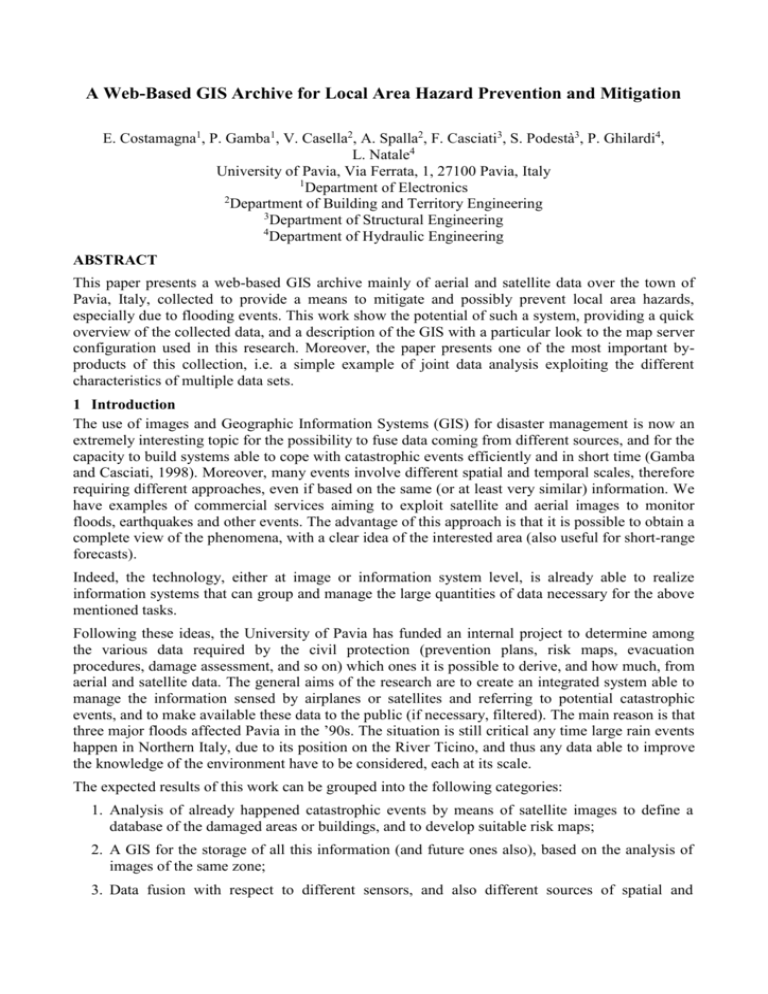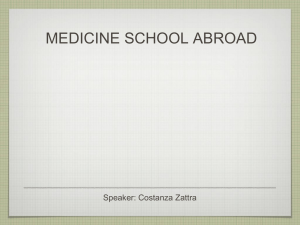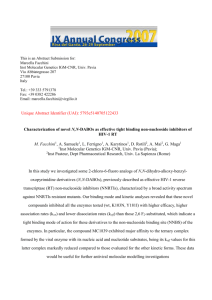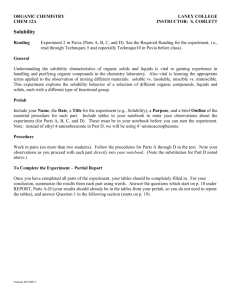A Web Based GIS Archive for Local Area Hazard Prevention and
advertisement

A Web-Based GIS Archive for Local Area Hazard Prevention and Mitigation E. Costamagna1, P. Gamba1, V. Casella2, A. Spalla2, F. Casciati3, S. Podestà3, P. Ghilardi4, L. Natale4 University of Pavia, Via Ferrata, 1, 27100 Pavia, Italy 1 Department of Electronics 2 Department of Building and Territory Engineering 3 Department of Structural Engineering 4 Department of Hydraulic Engineering ABSTRACT This paper presents a web-based GIS archive mainly of aerial and satellite data over the town of Pavia, Italy, collected to provide a means to mitigate and possibly prevent local area hazards, especially due to flooding events. This work show the potential of such a system, providing a quick overview of the collected data, and a description of the GIS with a particular look to the map server configuration used in this research. Moreover, the paper presents one of the most important byproducts of this collection, i.e. a simple example of joint data analysis exploiting the different characteristics of multiple data sets. 1 Introduction The use of images and Geographic Information Systems (GIS) for disaster management is now an extremely interesting topic for the possibility to fuse data coming from different sources, and for the capacity to build systems able to cope with catastrophic events efficiently and in short time (Gamba and Casciati, 1998). Moreover, many events involve different spatial and temporal scales, therefore requiring different approaches, even if based on the same (or at least very similar) information. We have examples of commercial services aiming to exploit satellite and aerial images to monitor floods, earthquakes and other events. The advantage of this approach is that it is possible to obtain a complete view of the phenomena, with a clear idea of the interested area (also useful for short-range forecasts). Indeed, the technology, either at image or information system level, is already able to realize information systems that can group and manage the large quantities of data necessary for the above mentioned tasks. Following these ideas, the University of Pavia has funded an internal project to determine among the various data required by the civil protection (prevention plans, risk maps, evacuation procedures, damage assessment, and so on) which ones it is possible to derive, and how much, from aerial and satellite data. The general aims of the research are to create an integrated system able to manage the information sensed by airplanes or satellites and referring to potential catastrophic events, and to make available these data to the public (if necessary, filtered). The main reason is that three major floods affected Pavia in the ’90s. The situation is still critical any time large rain events happen in Northern Italy, due to its position on the River Ticino, and thus any data able to improve the knowledge of the environment have to be considered, each at its scale. The expected results of this work can be grouped into the following categories: 1. Analysis of already happened catastrophic events by means of satellite images to define a database of the damaged areas or buildings, and to develop suitable risk maps; 2. A GIS for the storage of all this information (and future ones also), based on the analysis of images of the same zone; 3. Data fusion with respect to different sensors, and also different sources of spatial and temporal information; 4. Definition of a support system for aid in case of catastrophic events. To ease all these applications, and allow a fast and useful extraction of the information of interest (a crucial point for civil protection), all the information introduced in the GIS may be shared using direct web access. Data may be retrieved from any project partner or valid user through a very simple yet powerful interface. Different scales of analysis are possible, using many data sources, from cartographic data to aerial photographs, from coarse Digital Terrain Models to more precise LIDAR measurements, from multi-spectral to radar satellite sensors. The database is continuously updated, and will be integrated with new data coming from future available airborne and space sensors (e. g. SRTM, Envisat, Skymed/Cosmo). Finally, to train the potential users to a correct use of the site, the structure of the system includes an historical series of images about the town of Pavia, links to analysis of recently happened events in the area, and a few examples of remote sensing data analysis for disaster management and mitigation. 2 Pavia, its neighbourhood and its needs Pavia is crossed by the Ticino River and not far from the Po, the major Italian river. The city of Pavia can be inundated by Ticino floods or, more often by Po backwaters, since Pavia is located not far from the confluence of the two rivers. In the neighbourhood of Pavia there are many smaller towns and important infrastructures: two highways and railways connecting major cities such as Milano, Torino and Genova, and lots of roads with heavy traffic load. All these roads and rails make use of several bridges to cross the many rivers and channels existing in the country. Pavia neighbourhood is subject to floods: during the last decade Pavia was partially flooded four times, but many other towns were periodically flooded in the country around Pavia: these floods caused a few casualties, and sometimes relevant damages to bridges and other important buildings. Some bridges are still closed, after being totally or partially destroyed by recent flood events. Some floods were close to important factories, and some other caused the temporary interruption of railways and roads. While Pavia and its nearest neighbourhoods are on a flat area, in the southern part of the country near Pavia there are hills that are frequently affected by landslides that very often are contemporary to flood events. For all the mentioned reasons the local Administrations are putting an effort in monitoring the country: many rainfall and river level data are radio transmitted from the gauges and collected in real-time in computers and data are analysed to quantify the hydrogeological risk and to help in emergency planning, even during a catastrophic event. For the city of Pavia, a real-time forecasting system has been set up to forecast with a reasonable time advance possible floods. The system is based on data gathered from a monitoring network. A statistical simulation model, whose structure step-by-step linearizes the equations of the hydraulic process, forecasts flood levels in Pavia. The parameters of the model are estimated and updated every hour through a recursive procedure. The model gives the water stages of Ticino in Pavia with a lead-time that equals the transfer time of the flood waves. The warning system consists of three fundamental elements: monitoring network, forecasting model, and decision maker. Reliability of warning systems depends firstly on the correct operation of the monitoring network. This network, functioning on a 24-hours basis, activates the forecasting model when the onset of a flood event is observed: the model activates the decision maker when the forecast water levels become threatening. Pavia The province of Pavia Fig.1: A map of the major flood events in the last years around Pavia. 3 The Web archive To cope with some of the requirements outlined above, we considered the opportunity to build a web archive containing all the remote sensed data sets available from different structures and Departments inside the University of Pavia, to join the same data sources as well as the capabilities to analyse and interpret them. To this aim, a digital interactive archive was conceived and realized, starting from aerial, satellite and cartographic data, and providing a common framework using a web map server and, in particular, a product from Autodesk called MapGuide, rel. 4. We have installed it on a computer equipped with MS Windows NT4 Server and MS IIS (Internet Information Server); MapGuide is able to serve on the net vector and raster graphic data, as well as database data linked with them. MapGuide is able to read directly raster data format, such as TIFF, GeoTIFF, JPG, BMP, PNG and GIF; they can be georeferenced by means of a, so-called, world file (for GeoTIFF file the world file is not necessary, of course). For vector data, MapGuide has a proprietary file format, called SDF; nevertheless it is equipped with quite a universal format converter, able to read the main GIS formats such as: Intergraph DGN, ESRI Shape (SHP) and coverage, MapInfo MIF/MID, Autocad 14 DXF and DWG. The next release of the product will be able to read directly all the listed vector formats and will also be able to support linetypes, in order to increase the appearance of the showed maps. 3.1 Available data sets The archive is based on data coming from many different sources and at different resolution, even if all useful for our aim. In particular, we have both two-dimensional and three-dimensional data, allowing characterization of the area of interest not only in terms of soil classes or different terrain usage categories, but also with respect to the elevation. By combining the two kinds of data, we expect (following Haala, 1999 or Madhok and Landgrebe, 1999) to have a more detailed analysis of the Pavia area and to able to extract more interesting parameters for local hazard prevention and risk analysis. In particular, we have a number of different data sources, from cartography, to aerial and space acquired data from different sensors. In the following we give a brief description of the data sets currently available in our archive. We have three different kinds of maps. Going from smaller to bigger scale ratios, there is the regional map, at the scale 1:10000, in raster format; then there is the city map of the municipal territory, at the scale of 1:2000, in vector format, and, at the end, we have a very detailed map of the old town centre, at the scale 1:500; currently it is in the raster format, but we are digitising it and we have already four sheets in vector form. A first LIDAR data set has been acquired on the town of Pavia and its immediate neighbourhood in mid-November 1999 with the Toposys sensor. The flight height was around 850 meters (with the exception of two cross stripes, flying at half that height); the Toposys sensor is able to acquire, flying at that height, approximately five points per square meter, so that the one-meter grid which is usually delivered to the customers, and that we used, can be calculated with a good reliability. Up to now the Toposys instrument isn’t able to measure the reflected signal intensity, so it gives pure geometric data and it can acquire first pulse or last pulse alternatively. Therefore, to test all the operational capabilities of the sensor, three different acquisitions have been performed: they are illustrated by the Table 1, following. The grid data was delivered with 1-meter cells, as well as the so called raw data, that is, sparse points measured by the sensor. A second LIDAR data set is available, obtained during a second flight campaign in December 1999, and acquired by an Optech ALTM 1210 sensor. The Optech sensor was mounted on a Gazelle helicopter; it is able to measure, for each emitted laser pulse, the first pulse, the last pulse and also their intensities; all these data can be usefully exploited for classification purposes. Besides, it has a great operational flexibility so, to test the instrument, three different zones have been outlined and each of them has been scanned with different configuration parameters: flight height, scan angle, frequency of the scan lines. Only the raw data was delivered (to lower costs), so now we are calculating grid data by means of different geostatistical methods, mainly kriging. Fig. 1: Profiles of the laser datasets Fig. 1 shows the profiles of the acquired areas; T1, T2, T3 indicate Toposys datasets, while O1, O2, and O3 indicate Optech datasets. It can be easily seen that coverage for most of the town and municipal territory has been acquired. There is also good overlap between the Toposys and Optech data, in order to have the possibility to compare them. Table 1 shows the main flight parameters. Moreover, thanks to the well-equipped and powerful plane, we could also acquire, during the first laser flight, aerial photogrammetric images. The camera focal length is 153 mm, the flight height is 850 m, and the photographs have been scanned at 21m, so the ground resolution is 0.2 m. Images published on the web have been resampled to obtain 1-meter images, to simplify the analysis, to limit the download time, and to make the image pixel size as big as the cell size of the laser scanning derived DTMs. T1 T2 T3 O1 O2 O3 80000 80000 80000 10000 10000 10000 Scan lines acquired in a second 625 625 625 15 25 7 Acquisition mode LP FP LP FP&LP FP&LP FP&LP Flight height 850 m 850 m 400 m 600 m 650 m 500 m Plane speed 70 m s-1 70 m s-1 70 m s-1 30 m s-1 50 m s-1 20 m s-1 Points measured in a second Scan semiangle 7° 7° 7° 15° 20° 10° Scan line length 209 m 209 m 98 m 321 m 473 176 Distance between two points on the same line 1.66 m 1.66 m 0.78 m 0.97 m 2.38 m 0.25 m Distance between homologous points belonging to two consecutive lines 0.11 m 0.11 m 0.11 m 2.00 m 2.00 m 2.86 m 5.47 5.47 11.63 1.04 0.42 2.83 Average density (points per square meter) Table 1: Main parameters of the laser flights on Pavia Nevertheless, thanks to the well-equipped and powerful plane, we also acquired, during the laser flight, aerial photogrammetric images that will be considered in the following. Images have a ground resolution of much less than 1 meter and have been resampled to obtain a 1-meter grid, to simplify the analysis. In a totally different context, AIRSAR data has been made available. AIRSAR (AIRplane SAR, see Zebcker et al., 1992 and Madsen et al., 1995) is operated by the Jet Propulsion Laboratory for development and demonstration of advance SAR imaging methodologies, and for data acquisition for scientific projects. This airborne SAR system is flown on a NASA DC-8 aircraft, at a nominal altitude of 11,000 meters. The radar operates at multiple frequencies (C, L, and P) bands, and is fully polarimetric. The interferometric measurements are at C and L bands. The interferometric mode of the AIRSAR system is called TOPSAR (for topographic SAR). Nominal IFSAR data acquisition covers a 12 km swath in the range direction. The data posting is 5 meters with a quoted vertical accuracy of 2.5 meters. AIRSAR flew over Italy in 1989, and in particular a few images taken from those flights were acquired over the area just South of Pavia and over the river Po (called Oltrepo’). As for satellite (or, better, space) images, our first data set comes from the SIR-C sensor (Shuttle Imaging Radar in the C-band. Moreover, SIR-X (Shuttle Imaging Radar in the X-band) images over the Pavia area have been acquired. The SIR-C/X-SAR project was a cooperative effort of NASA, the German space agency (DLR) and the Italian Space Agency (ASI) for earth observation at microwave frequencies. Indeed, SIR-C acquired data in the L (= 23 cm) and C ( = 5.8 cm) bands, and at four polarization combinations (HH, HV, VH, VV, where H stands for horizontal and V for vertical). SIR-X, instead, recorded the backscattered electromagnetic field in the X band ( = 3.1 cm) and with only the vertical polarization (VV images). The images were collected only on selected areas of the earth, because of the high data rate involved in the recording process (more than 200 Mbytes per second), and have 30 x 30 meters ground resolution. Since Pavia was on many of the shuttle flight lines, we were able to collect a number of different images from both sensors over our research area. The use of these data is extremely important to characterize at different microwave frequencies the materials and surface characteristics of a studied area. A further considered data source is the radar sensor on board of the ERS satellites This sensor operates in the C-band (5.3 GHz), and is able, while working in image mode, to provide data with a spatial resolution of 26 m in range (across track) and between 6 and 30 m in azimuth (along track). The data acquired for this project refer to the three major flood events in the area around Pavia, respectively in September 1992, October 1993 and October 1994. Data are slant range raw data coming from the ERS-2 satellite and covering a large area around the town of Pavia, nearly a square with a side of 100 Km. This exploits the capability of microwaves to penetrate clouds and provide all-weather images of the ground. Finally, optical data coming from the Russian satellite Cosmos have been acquired, dating 1985, and covering the town of Pavia and the rivers Ticino and Po. The satellite photographs are produced by the camera systems on Russian Cosmos spacecraft, placed in orbit by Russian booster rockets. This camera allows for the production of both two-meter and ten-meter imagery: with the two-meter images we are able to identify an object 2 meters or larger; it is produced by the KVR 1000 camera system. This kind of camera provides large area coverage in a single frame or scene; the individual scenes cover a usable area of 40 KM by 160 KM, and the pixel size is 1.56 meters. The KVR-1000 camera with its 1000mm lens provides the two-meter resolution panchromatic imagery at an average scale of 1:220,000. The format is 18 cm with single frame coverage of 40 km by 180 km but imagery is also available in sub-frames. The data is single band with a spectral range of 510-760 nm. The KVR-1000 images are overlaid for precision, making them ideal for precision base mapping and wide area coverage applications. 3.2 Current capabilities The actual, preliminary version of the system has a configuration where the principal components of the GIS and database structure are defined (Fig. 3). Currently, data sets are deposited in a distributed archive on different machines, while the central database management section, based on the map server already described, maintains a repository of metadata regarding each set. The metadata contains information about the geographical area covered by the image, data characteristics (in terms for instance of sensor type, data quality, ground resolution, data type) and a few annotations about usefulness of the considered set for different kinds of applications. Query management is based over this information, while actual data retrieval for the moment is not available, due to a lack in data policy, as noted in next subsection. Web interface Hystorical archive Data samples and description Examples of data analysis Metadata repository map server query and visualization Distributed database Fig. 3: The conceptual structure of the current system implementation. The starting point of the system is on the project web page (Fig. 4). The acronym chosen for the project reflects the importance of having data acquired from multiple remote sensing sources over the same test area, to provide a working environment for future data comparison and fusion algorithms, and to work with the distributed digital archive in an interactive manner. So, the acronym MURA DI PAVIA (Walls of Pavia), from Multisensor Urban Research Area: a Digital Interactive archive of PAVIA was chosen. Fig.4: The MURA DI PAVIA home page. From this page we may obtain a few information about the town of Pavia and its neighbourhood, the recent history of the town in term of disasters and hydrogeological problems related with the site, as well as a description of the different data sets contained in the digital archive, some applications and researches already carried on by the groups referring to this project using part of the archive, and finally the archive portal (Fig. 5). Fig.5: Data set descriptions (on the left) and the archive portal. The portal introduces authorised users to the map server main window, from where it is possible to query in different ways the database, and visualize a GIS environment. Up to now, the map server only offers the possibility to see a graphical catalogue of the data available. There is a lowresolution raster background and there are the enclosing polygons of all the objects: aerial pictures, map sheets, laser data. Each object is linked with a data base table containing, among the other things, a unique key which is showed by the server, on the fly, when the cursor stay at rest above some feature. We believe that the two functions of seeing what is available and downloading it must be kept separated for two reasons: first of all, our data are very heavy to download and an unscrupulous usage of the download feature could simply paralyse the server; further, in Italy the diffusion of territorial data, such as aerial images or maps, is restricted by the law. For these reasons we think that the best strategy to manage our site is to give to almost everybody the possibility to know which data exist on the server. Then, thanks to the possibility offered by our map server to filter users, we will offer only to the authorized user the possibility to go to the download page. We have also developed a strategy to ease and speed up the download, based on tiling: we have superimposed to the main part of the area the so called standard 500 metres grid, and we plan to decompose as much data as possible according to that grid. The bigger problems come from aerial images and laser data; vector maps are small and also the raster maps are not so heavy. For aerial image files, we have two resolutions: the full one corresponds to a ground pixel size of 11 cm and to a file size of 120 MB; the lighter one has a ground resolution of 1 m and a file size of 1.5 MB: images of this type could be effectively used to have a general overview of the territory. We also plan to derive high quality orthophotos from laser-derived DTM and from aerial images; once obtained, we will be able to cut them to obtain standard tiles that will occupy, at full resolution, approximately 20 MB. For laser data we have already tiled raw data as well as grid data. Fig.6: The map server layers visualizing the available maps and the standard 500m grid. 3.3 Future implementations The actual structure of the site lacks a few critical issues that need to be addressed in the near future. First of all, due to different data politics among all the structures that provided data to the common GIS, it is necessary to amalgamate the viewpoints and to try to define a common playground for actors working on the political, research and civil protection sides. Second, more of the “a priori” knowledge about data importance and usefulness for specific application should be translated into the database, to promptly and timely guide the user to the information he/she is looking for (or, at least, the data from which extract these info). As for the first point, it should be noted that one of the major problems to be faced in the near future is related to the necessity to provide a way to collect all or part of these data by different operators, such as research groups inside the University of Pavia, the civil protection, and other possible research users. More interest deserves also the definition of a navigation tool able to guide the inexperienced user inside the wide variety of the available data sets, exploiting (in terms of resolution, and data characteristics required) the application for which he or she is searching the database. 4 An example of joint (or disjoint) data analysis One of the capabilities of the system, as already outlined, is the unique possibility to work on different data sets collected over the same research area, to prepare and tune analysis algorithms that may exploit all the capabilities of such a large possible data fusion procedure. The final goal is to provide user-friendly and simple tools to interact with all or at least many of the data sets in the GIS and extract further processed information to be added to the database, but also to be able to analyse, in case of need, new data sets coming to integrate the existing system. In the following, we will outline only on of these possible applications, to give an example of these tools. 4.1 LIDAR+optical data for building extraction In laser scanning the most challenging part is the elimination of objects on the Earth’s surface to produce a Digital Terrain Model (DTM). Various kinds of algorithms have been developed; however, presently there is no universal filter available, which gives satisfying results in any kind of terrain. In river basins there is often the task to eliminate buildings and vegetation of 1m to 2 m height, while on the other hand embankments of the same height shall be maintained. The required automatic discrimination between the different object types is very difficult or even impossible if only geometric information from laser scanning is available. Even rough characterization of spectral surface properties like those provided by aerial photographs may help to automatically discriminate between different object classes and thus enable a better and more intelligent filtering of the laser data. Indeed, DTM generation from laser scanning data implies essentially that laser echoes generated by natural objects not belonging to the ground, such as trees, are eliminated; at the same time it is also necessary to filter out echoes coming from man-made objects, such as buildings. Many different filtering techniques have been proposed. They are mainly based on the observation that, on an area of a reasonable extension, ground points and tree points will constitute two disjoint sets and these two sets are characterized by significantly different values of the average height. It should be useful instead to apply the mapping capabilities of different land use classes provided by an optical sensor to range measurements of the objects in the same area, to recognize them (and filter them out, if necessary) or to better determine their 3D shape and 2D footprint). More in detail, the reasons of the usefulness of optical images for the aspired applications are: Image data in the visible spectral range enables a good discrimination between vegetation and non-vegetation areas or between different land use classes. Since surface vegetation is strongly correlated with the required hydraulic roughness, the result of land use classification provided very important input parameter for flooding simulation. If, furthermore, spectral information in the mid-infrared spectral range (like those provided by the … sensor, see previous section), the classification of different vegetation types may be more easily obtained. In contrast to the spatial resolution of the other spectral channels for this spectral band a reduced spatial resolution is sufficient. Conversely, the detection and classification capabilities of the optical measurements may be improved by exploiting the higher ground resolution of LIDAR measurements, especially if both the first and the last pulse are available. Last pulse refers to the last reflection of the emitted laser pulse (which usually refers to the terrain surface), while the first pulse is the first reflection of the laser pulse collected by the scanner. Indeed, for the bare earth first and last pulse are identical, while on the presence of vegetation this first pulse refers to reflections of the laser pulse by this vegetation, so that the difference between first and last reflection can give hints on the height of this vegetation. These LIDAR data can be used to formulate decision rules for categorizing pixels and merged with the spectral analysis available by optical and near-infrared measurements. The following results (Fig. 7) refer to a joint or disjoint classification of LIDAR and visible data over a small part of Pavia where natural (vegetation, river) as well as man made features (buildings, roads) are present. Classifications are obtained by means of a hierarchical fuzzy tool already developed (Gamba and Savazzi, 1998), and refer to only LIDAR data (Fig. 7b) or LIDAR in conjunction with visible data (Fig. 7a). In particular, in Fig. 7d the classification map obtained using only the aerial image is compared with the one extracted from LIDAR data (Fig. 7c) and, finally in Fig. 7e the joint classification results are presented. (a) (c) (b) (d) (e) Fig. 7: Original data and classification results over a small area in Pavia: (a) a resampled and coregistered aerial image; (b) Toposys LIDAR data; (c) classification results using only LIDAR data; (d) classification results using only the aerial image; (e) classification results using both LIDAR data and the aerial image. We observe that the aerial image provides more details, allowing discrimination between garden paths and green areas at the terrain level, while LIDAR data is extremely useful to separate buildings from the background. Another example is that the roof of the major building (Collegio Borromeo), due to the different position of its parts with respect to the sun, is differently classified if the aerial data alone is considered. This incongruent feature has been fixed using LIDAR data. 5 Conclusions This work shows the tremendous possibilities provided by a GIS archive of remote sensed data. In particular, a few problems related with urban remote sensing have been addressed, through which we may try to give a solution by the use of data sets acquired by multiple sensor over the same test area. We also provided a brief overview of the (very simple) tools actually available to query and use the web interface of the archive, highlighting possible drawbacks as well as the advantages of such an approach. Future implementation will take into account the possibility to provide interactively the data sets referring to a given location, taking into account the “a priori” knowledge of the experts belonging to the project to give a sort of pre-selection among all the data. The idea is to help the user to find his/her way in the growing database provided he/she has in mind the kind of data application. So, DTM extraction for runoff flooding analysis may lead to LIDAR data if detailed information are required or to SRTM data (as soon they will be available) if a coarser resolution is sufficient. Many analyses on the data will also be considered, starting from three-dimensional urban structure extraction, as already considered in Gamba and Houshmand, 1999, Gamba et al., 2000 and Gamba and Houshmand, 2000, with the aim to promote an automatic way to analyse the urban environment. 6 Acknowledgments The ongoing effort on this research was not possible without the funds coming mainly from the “Progetto d’Ateneo” funding initiativeinternal to the University of Pavia. However, many of the data sets come from the four groups interactively working on this project, and were made available thanks to many agencies. We wish to thank first Jet Propulsion Laboratory, Pasadena, USA for the AIRSAR and SIR-C data, DLR for the SIR-X data, and particularly the Italian National Research Project entitled Digital surface modelling by laser scanning and GPS for 3D city models and digital ortophoto, financed by the Italian Ministry of the University for the 1998, for providing both the LIDAR data sets. 7 References Casella V., Galetto R., 1998. Tecniche innovative per il rilevamento terrestre, aereo e da satellite – Proceedings of the II ASITA Conference, pagg. 33-53, Bolzano, Italia, 24-27 November 1998. Casella V., 1999. Introduction to airborne laser scanning, a GPS-INS based technique – Reports on Geodesy n. 3 (44), 1999, Warsaw University of Technology, pagg. 249-254, ISBN 83-85287-43-4. Casella V., 1999. Le potenzialità del laser scanning per la conoscenza del territorio – Bollettino SIFET, n. 1, 1999, pagg. 87-96, ISSN 0392 4424. Gamba, P., Casciati, F., 1998. GIS and image understanding for near real-time earthquake damage assessment, Photogrammetric Engineering and Remote Sensing, Vol. 64, n. 10, pp. 987-994. Gamba P., Houshmand B., 1999. Three-dimensional urban characterization by means of IFSAR measurements, Proc. of the 1999 IEEE International Geoscience and Remote Sensing Symposium (IGARSS’99), Vol. V, pp. 2401-2403, Hamburg, Germany. Gamba P., Houshmand B., Saccani M., 2000. Detection and extraction of buildings from interferometric SAR data, IEEE Transactions on Geoscience and Remote Sensing, Vol. 38, n. 1, pp. 611-618. Gamba P., Houshmand B., 2000. Digital surface models and building extraction: a comparison of IFSAR and LIDAR data, accepted on IEEE Transactions on Geoscience and Remote Sensing. Gamba, P. and Savazzi, P., 1998. Classification of urban environments in SAR images: a fuzzy clustering perspective, Proc. of IGARSS’98, Vol. I, pp. 351-353. Haala, N., 1999. Combining multiple data sources for urban data acquisition. Proc. of the Photogrammetric Week 1999, Stuttgart, Germany. Madhok, V. and Landgrebe, D., 1999. Supplementing hyperspectral data with digital elevation, Proc. of IGARSS'99, Vol. I, pp. 59-61, Hamburg, Germany. Madsen, S.N. Martin, J.M., Zebker, H.A., 1995. Analysis and evaluation of the NASA/JPL TOPSAR across-track interferometric SAR system, IEEE Trans. on Geoscience and Remote Sensing, Vol. 33, No. 2, pp. 383-391, 1995. Zebker, H.A., Madsen, S.N., Martin, J.M., Wheeler, K.B., Miller, T., Lou, Y., Alberti, G., Vetrella, S., Cucci, A., 1992. The TOPSAR interferometric radar orographic mapping instrument", IEEE Trans. on Geoscience and Remote Sensing, Vol. 30, No. 5, pp. 933-940.




